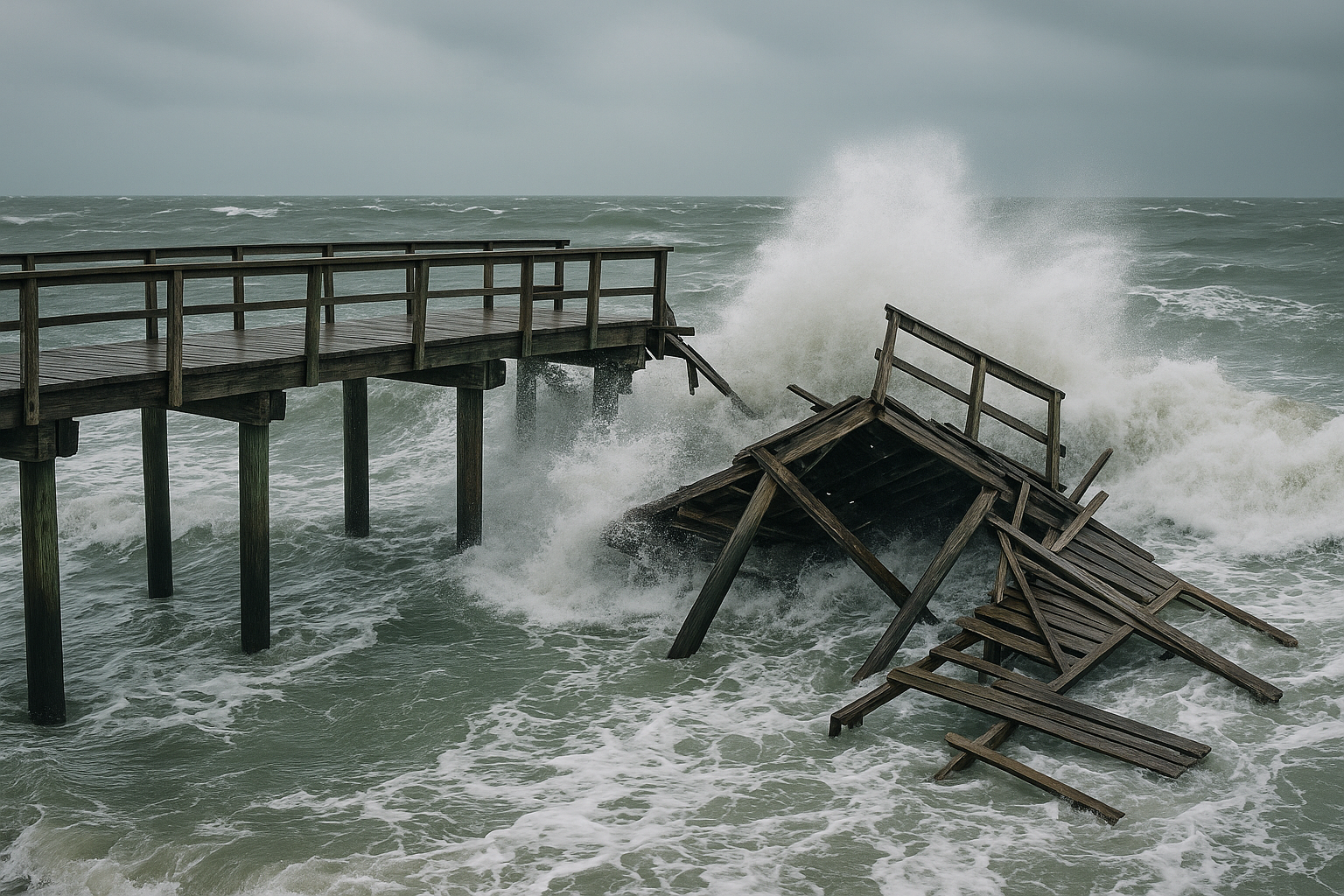If you are a waterfront property owner, you understand the critical role that bulkheads and seawalls play in protecting your investment from the relentless forces of the sea. These marine construction structures are more than just barriers; they are the first line of defense against soil erosion, hydrostatic pressure, and the direct wave force that can compromise the integrity of your shoreline.
Whether you are dealing with a deteriorating bulkhead or considering the installation of a new seawall, staying updated on the latest advances in bulkhead and seawall technologies is essential for long-term protection and the preservation of your coastal property.
Bulkheads and seawalls, often used interchangeably, serve distinct purposes but share a common goal: shoreline stabilization. Bulkheads are typically vertical structures designed to retain soil and prevent erosion, while seawalls are broader barriers that protect against wave action and surcharge loads on the soil. As real estate values continue to rise in coastal areas, the importance of robust and reliable seawall and bulkhead systems cannot be overstated.
In this article, we will delve into the latest innovations and strategies that can help you future-proof your waterfront property, ensuring it remains a safe and valuable asset for years to come.
Environmentally Friendly Materials and Design
Eco-Conscious Materials
When it comes to constructing or repairing bulkheads and seawalls, the choice of materials can significantly impact the environmental footprint of your project. Traditional materials like concrete and steel, while durable, come with substantial environmental costs due to their energy-intensive production processes and associated emissions.
However, modern innovations have introduced a range of eco-friendly alternatives that are both sustainable and effective.
Recycled vinyl and fiber-reinforced polymer (FRP) composites are among the leading eco-conscious materials used in seawall construction. These materials, such as those offered by companies like Everlast Seawalls and Decks & Docks, are made from high-quality recycled vinyl formulations that are UV-resistant and do not rot or rust over time. This not only reduces the need for frequent repairs and replacements but also minimizes the ecological impact by avoiding the use of materials that can degrade and harm marine ecosystems.
Another notable example is the Truline U-Channel form, which is made from over 92% post-industrial recycled material. This approach ensures a long lifespan of over 75 years, making it a highly sustainable option for seawall construction.
Integrated Ecosystems
Beyond the materials themselves, the design of bulkheads and seawalls can also be tailored to integrate seamlessly with the surrounding ecosystem. Modern seawall designs often incorporate features that support local biodiversity and minimize disruption to natural habitats. For instance, smooth and flat surfaces on seawalls can enhance water flow and reduce noise, creating a safer and more hospitable environment for both humans and wildlife.
This is particularly evident in installations such as those by CMI, where the sheet piling solutions are designed to blend with the natural elements of the surroundings, protecting the land without compromising the aesthetic or ecological balance.
Additionally, low-impact installation techniques such as hydraulic jacking or vibration-free sheet piling can significantly reduce the disturbance to local ecosystems during the construction process. These methods ensure that the installation of seawalls and bulkheads does not harm the delicate balance of marine and coastal environments, thereby supporting the health and resilience of these ecosystems .
Technological Innovations in Construction and Maintenance
Automation and Robotics in Construction
The construction and maintenance of bulkheads and seawalls are undergoing a significant transformation with the integration of automation and robotics. These technologies, though more commonly associated with industries like shipbuilding, are now being applied to marine construction projects to enhance efficiency, precision, and safety. Robotic systems can automate tasks such as the installation of sheet piling, reducing the reliance on manual labor and minimizing the risk of human error.
This automation ensures that each pile is driven to the exact depth and alignment required, improving the structural integrity of the seawall or bulkhead.
Additionally, robotic technologies can streamline the repair and maintenance processes. For instance, automated inspection drones and underwater robots can conduct detailed inspections of seawalls and bulkheads, identifying potential issues before they become major problems. This proactive approach not only extends the lifespan of these structures but also reduces the overall maintenance costs by addressing problems early.
Smart Monitoring Systems
Advances in monitoring technology have also revolutionized the way we maintain and manage bulkheads and seawalls. Smart monitoring systems, equipped with sensors and IoT devices, can continuously monitor the condition of these structures in real-time. These systems can detect changes in hydrostatic pressure, soil stability, and other critical factors that could indicate potential failures or erosion issues.
By providing immediate alerts and detailed data, these systems enable property owners and maintenance teams to take prompt action, preventing catastrophic failures and ensuring the long-term stability of the shoreline.
These smart systems can also integrate with weather forecasting data to predict and prepare for extreme weather conditions such as storms and high tides. This predictive maintenance approach allows for proactive measures to be taken, reinforcing the structures if necessary, and ensuring that they remain resilient against the forces of nature.
This level of monitoring and predictive maintenance is essential for protecting valuable coastal properties and preventing costly repairs down the line.
Adaptation Strategies for Rising Sea Levels
Dynamic and Flexible Design Solutions
As sea levels continue to rise, the need for adaptive and resilient coastal protection strategies becomes increasingly critical. One of the key approaches is the implementation of dynamic and flexible design solutions for bulkheads and seawalls.
Flexible structures, such as those made from interlocking armor layers or semi-rigid materials, are designed to tolerate a significant degree of displacement and shifting without compromising their integrity. These flexible revetments can absorb and distribute the forces of waves and tides more effectively, reducing the risk of structural failure even under changing sea level conditions.
For instance, modified bulkhead approaches involve using materials that can flex and adjust to the movement of the soil and water. This includes the use of lighter yet robust materials such as vinyl and fiber-reinforced plastic sections, which can be installed in areas subject to moderate wave action.
These materials provide the necessary flexibility to adapt to the dynamic conditions of the coastline, ensuring the structure remains stable and effective over time.
Collaborative Coastal Management
Adapting to rising sea levels also requires a collaborative and integrated approach to coastal management. This involves working with local communities, government agencies, and environmental organizations to develop comprehensive strategies that address the multifaceted challenges of coastal erosion and flooding. Collaborative efforts can focus on creating adaptive plans that include the installation of seawalls and bulkheads, as well as other measures such as beach nourishment, dune restoration, and the implementation of green infrastructure.
Effective coastal management also involves continuous monitoring and assessment of the coastline. This includes regular inspections of existing seawalls and bulkheads to identify areas that may need reinforcement or repair.
By leveraging advanced technologies such as drones and IoT sensors, stakeholders can gather real-time data on coastal conditions, enabling more informed decision-making and proactive maintenance. This collaborative and data-driven approach ensures that coastal protection measures are not only effective but also sustainable and resilient in the face of rising sea levels.
Conclusion
No matter the scope or stage of your waterfront project—whether you’re building new, making repairs, or preventing erosion—Gulf Coast Waterfront Solutions is your trusted partner along the Texas and Gulf Coast shorelines. Since 1996, we’ve delivered durable, attractive, and code-compliant marine construction with zero upfront payment and a commitment to quality craftsmanship.
From bulkheads and floating docks to shoreline maintenance and permitting support, our team is ready to protect and enhance your property. Contact us today for a free estimate and discover why homeowners, developers, and businesses rely on Gulf Coast Waterfront Solutions to build smarter, stronger waterfronts that last.
FAQ
What are the key components of a holistic approach to bulkhead installation, and how do they ensure superior performance and environmental safety?
A holistic approach to bulkhead installation includes polymer grout injection to address structural issues, hydrostatic pressure control to manage water pressure, and the use of environmentally friendly, NSF-certified materials. This method ensures superior performance by maintaining structural integrity and promotes environmental safety by adhering to public health and aquatic environment standards .
How does the Truline system combine different materials to enhance the durability and longevity of seawalls and bulkheads?
The Truline system combines the strength of steel-reinforced concrete with the protection of a modular and protective vinyl form. Steel rebar is placed inside the vinyl forms, and then concrete is tremie poured in place, creating a wall that is protected from environmental degradation and can last 75+ years when properly designed and installed .
What are the benefits of using a vinyl seawall cap, and how does it compare to traditional capping materials in terms of maintenance and longevity?
The benefits of using a vinyl seawall cap include its UV-stabilized, anti-skid, and slip-resistant finish. It is lightweight, easy to handle, and requires no maintenance.
Unlike traditional caps, vinyl caps do not corrode, splinter, or decay, ensuring a long-lasting solution that exceeds the durability of pressure-treated or concrete caps .
How can advanced technologies such as polymer grout injection and drone-based inspections contribute to the future of bulkhead and seawall construction?
Advanced technologies like polymer grout injection can extend the lifespan of bulkheads and seawalls by stabilizing soil, sealing leaks, and preventing erosion. Drone-based inspections enhance monitoring and maintenance by providing detailed, real-time assessments of structural integrity, allowing for early detection and targeted repairs, thus optimizing resource allocation and reducing costs .

